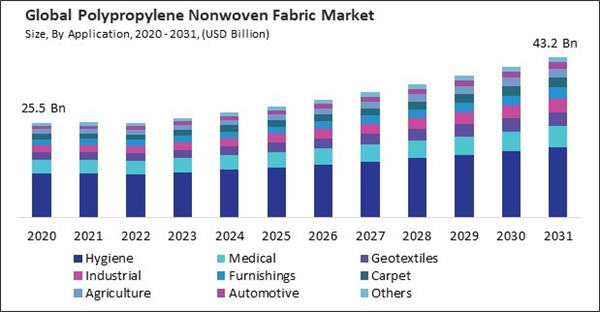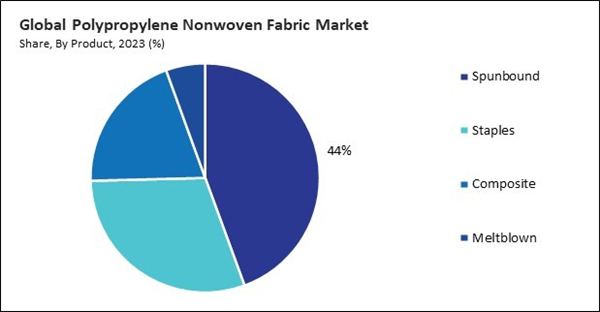The Global Polypropylene Nonwoven Fabric Market size is expected to reach $43.2 billion by 2031, rising at a market growth of 6.3% CAGR during the forecast period. In the year 2023, the market attained a volume of 13,927.1 Kilo Tonnes, experiencing a growth of 5.7% (2020-2023).
Geotextiles made from polypropylene nonwoven fabrics act as filters in drainage applications. Therefore, the geotextiles segment will capture 8.7% of total revenue share in the market by 2031. Also, in Russia, Geotextiles would utilize 59.4 Kilo Tonnes of Polypropylene Nonwoven Fabrics by 2031. They allow water to pass through while retaining soil particles, preventing clogging and maintaining the efficiency of drainage systems. These separate soil layers in road construction and other infrastructure projects.
Polypropylene nonwoven fabrics can be engineered to have a soft and comfortable texture, making them suitable for applications in hygiene products such as diapers, sanitary napkins, and adult incontinence products. Consumer preference for soft and comfortable materials has driven the adoption of polypropylene nonwovens in these products. Therefore, the growing demand for hygiene products is propelling the growth of the market.
Additionally, technological advancements have introduced more sophisticated manufacturing techniques for producing these fabrics. Modern methods, such as meltblown and spunbond processes, enable manufacturers to produce fabrics with specific characteristics, including fine fibers, uniformity, and enhanced strength. Hence, growing technological advancements are propelling the growth of the market.
However, competition from alternative materials is a significant restraint for the market. Various industries have alternatives to polypropylene nonwoven fabrics, and the choice of material depends on cost, performance, sustainability, and specific application requirements. Natural fibers, such as cotton and bamboo, are considered eco-friendly alternatives to polypropylene. Therefore, rising competition from alternative materials hinders the growth of the market.
Geotextiles made from polypropylene nonwoven fabrics act as filters in drainage applications. Therefore, the geotextiles segment will capture 8.7% of total revenue share in the market by 2031. Also, in Russia, Geotextiles would utilize 59.4 Kilo Tonnes of Polypropylene Nonwoven Fabrics by 2031. They allow water to pass through while retaining soil particles, preventing clogging and maintaining the efficiency of drainage systems. These separate soil layers in road construction and other infrastructure projects.
Polypropylene nonwoven fabrics can be engineered to have a soft and comfortable texture, making them suitable for applications in hygiene products such as diapers, sanitary napkins, and adult incontinence products. Consumer preference for soft and comfortable materials has driven the adoption of polypropylene nonwovens in these products. Therefore, the growing demand for hygiene products is propelling the growth of the market.
Additionally, technological advancements have introduced more sophisticated manufacturing techniques for producing these fabrics. Modern methods, such as meltblown and spunbond processes, enable manufacturers to produce fabrics with specific characteristics, including fine fibers, uniformity, and enhanced strength. Hence, growing technological advancements are propelling the growth of the market.
However, competition from alternative materials is a significant restraint for the market. Various industries have alternatives to polypropylene nonwoven fabrics, and the choice of material depends on cost, performance, sustainability, and specific application requirements. Natural fibers, such as cotton and bamboo, are considered eco-friendly alternatives to polypropylene. Therefore, rising competition from alternative materials hinders the growth of the market.
By Product Analysis
Based on product, the market is divided into spunbound, staples, meltblown, and composite. In 2023, the spunbound segment garnered 44.4% revenue share in the market. Spunbonded polypropylene nonwoven fabrics are known for their strength and durability. The continuous filaments provide a high level of tensile strength, making them suitable for applications that require robust materials. In terms of volume, the spunbound segment would consume 9,159.7 Kilo Tonnes fabrics by 2028.Application Analysis
On the basis of application, the market is segmented into hygiene, industrial, medical, geotextiles, furnishings, carpet, agriculture, automotive, and others. In 2023, the medical segment attained 13.8% revenue share in the market. Nonwoven fabrics made from polypropylene are a primary component in producing face masks and respirators. In terms of volume, the medical segment utilized 1,987.4 Kilo Tonnes fabrics in 2023.Regional Analysis
Region-wise, the market is analyzed across North America, Europe, Asia Pacific, and LAMEA. The North America region generated 25.6% revenue share in the market in 2023. The North America region experiences a growing demand for hygiene and personal care products, including diapers, feminine hygiene products, and adult incontinence items. In terms of volume, Canada utilized 294.6 Kilo Tonnes fabrics in 2020.List of Key Companies Profiled
- Kimberly-Clark Corporation
- Berry Global Group, Inc.
- Schouw & Co.
- Mitsui Chemicals, Inc.
- Toray Industries, Inc.
- Freudenberg SE
- Ahlstrom
- Berkshire Hathaway, Inc.
- SABIC (Saudi Arabian Oil Company)
- Asahi Kasei Corporation
Market Report Segmentation
By Application (Volume, Kilo Tonnes, USD Billion, 2020-2031)- Hygiene
- Medical
- Geotextiles
- Industrial
- Furnishings
- Carpet
- Agriculture
- Automotive
- Others
- Spunbound
- Staples
- Composite
- Meltblown
- North America
- US
- Canada
- Mexico
- Rest of North America
- Europe
- Germany
- UK
- France
- Russia
- Spain
- Italy
- Rest of Europe
- Asia Pacific
- China
- Japan
- India
- South Korea
- Singapore
- Malaysia
- Rest of Asia Pacific
- LAMEA
- Brazil
- Argentina
- UAE
- Saudi Arabia
- South Africa
- Nigeria
- Rest of LAMEA
Table of Contents
Chapter 1. Market Scope & Methodology
Chapter 2. Market at a Glance
Chapter 3. Market Overview
Chapter 4. Global Polypropylene Nonwoven Fabric Market by Application
Chapter 5. Global Polypropylene Nonwoven Fabric Market by Product
Chapter 6. Global Polypropylene Nonwoven Fabric Market by Region
Chapter 7. Company Profiles
Companies Mentioned
- Kimberly-Clark Corporation
- Berry Global Group, Inc.
- Schouw & Co.
- Mitsui Chemicals, Inc.
- Toray Industries, Inc.
- Freudenberg SE
- Ahlstrom
- Berkshire Hathaway, Inc.
- SABIC (Saudi Arabian Oil Company)
- Asahi Kasei Corporation
Methodology

LOADING...










